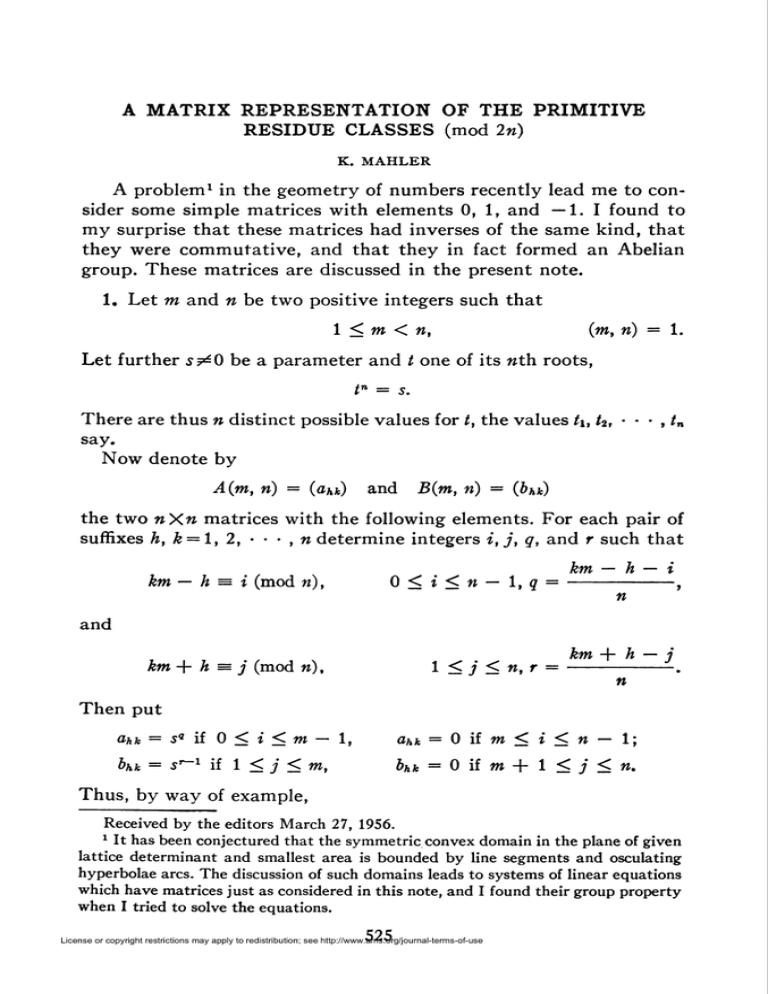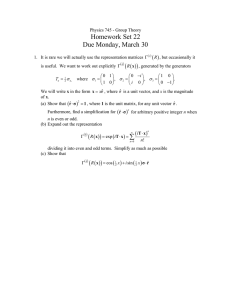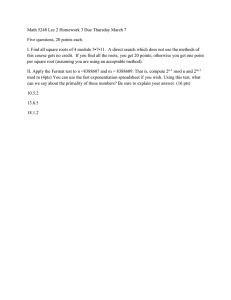A MATRIX REPRESENTATION OF THE PRIMITIVE RESIDUE
advertisement

A MATRIX REPRESENTATION OF THE PRIMITIVE
RESIDUE CLASSES (mod 2ra)
K. MAHLER
A problem1 in the geometry of numbers recently lead me to consider some simple matrices with elements 0, 1, and —1. I found to
my surprise that these matrices had inverses of the same kind, that
they were commutative,
and that they in fact formed an Abelian
group. These matrices are discussed in the present note.
1. Let m and ra be two positive integers such that
1 < m < ra,
Let further
i^Obea
parameter
(m, n) = 1.
and / one of its rath roots,
t" = s.
There are thus » distinct
say.
possible values for t, the values h, t2, ■ ■ ■ ,t„
Now denote by
A(m, ra) = (ahk)
and
B(m, n) = (bhk)
the two raX« matrices with the following elements. For each pair of
suffixes h, k = 1, 2, • ■ • , ra determine integers i, j, q, and r such that
km — h = i (mod w),
0 < i < ra — 1, q =-,
km — h — i
ra
and
km+ h = j (mod n),
1 < j < n, r =-.
km + h — j
ra
Then put
ahk = sq if 0 < i < m — 1,
ahk = 0 if m < i < ra — 1;
hk = s^1 if 1 < j < tn,
bhk = 0 if m + 1 < j < ra.
Thus, by way of example,
Received by the editors March 27, 1956.
1 It has been conjectured that the symmetric convex domain in the plane of given
lattice determinant
and smallest area is bounded by line segments and osculating
hyperbolae arcs. The discussion of such domains leads to systems of linear equations
which have matrices just as considered in this note, and I found their group property
when I tried to solve the equations.
525
License or copyright restrictions may apply to redistribution; see http://www.ams.org/journal-terms-of-use
526
K. MAHLER
1
0
S2 0 ]
10
5
S2 0
1 0
5
0
52 ,
0
1
5
0
52
.0
1 0
s
s2)
,4(3, 5) =
5
[June
[0
0
1
0
S
0
1 0
5
0 .
1
0
0
5
0
0
5
0
0.
01005
5(2, 5) =
(l
We shall study these matrices mainly in the case when m is odd
and 5 has the value —1, but, for the present, do not yet impose these
restrictions.
2. Denote by
* = (*a),
three variable
«X1
y = (yn),
matrices
(column
y = A(m, n)x
z = (zi,)
vectors)
and
such that
z = B(m, n)x,
or in explicit form,
n
n
yn = 23 &hkxk,
zh = 23 bnkXk-
A-l
Further
*=1
put, for shortness,
Y =
yi +
Z = t»-hl
tyt
+
t2y3 +
+
tn~2Z2 +
• • • +
■• • +
tn~xyn,
tZn-l +
Then
n
n
n
y = 23 23 <*-10****
= 23 ukXk
h-l
k—l
k—l
where
n
itk = 2Z th-lank,
h-i
and similarly
n
n
n
z = 23 23 tn~hbhkxk
= 23 »***
A-l *-l
*-l
where
n
»* = 23 in~hbhk.
n-i
License or copyright restrictions may apply to redistribution; see http://www.ams.org/journal-terms-of-use
Zn-
i957l
PRIMITIVE RESIDUE CLASSES
3. These expressions can be replaced
definition of a»* it is evident that
r^lh-i^ina+h-i^ikm-i-i
t"-lahk=<
527
by simpler
ones. From
;f km—h = nq+i,
0<i<m—l,
.
(.0
the
if km—h = nq+i, m<i<n
—l.
Therefore
n
m—1
1 _
im
uh = 23 <*_1a**= 23 thm-i-x = f(*-i)»-,
h—l
i=0
1 — t
whence
n
1 _
y = 23<(i_1)m-**
k-i
i -
im
t
i — j-
=-(xi
+
On combining
Jmx2 +
/2mx3 +
this formula
with
ty2 +
■■■ +
• • • +
i(n-1)mx„).
the definition
of Y, we obtain
the First Identity,
(1 ~ t)(yx
+
=
t2y3 +
(1 -
tm)(Xi
+
i"-»y»)
tmXt +
t2mx% +
• • • +
*tn-1)mx„).
Similarly, by the definition of bht,
{sr-Hn-h=tnr~h=tkm-j
tn-hbhk=
jf km+k
= nr+j,
1</<W,
{
(.0
if km+h = nr+j,
m+l<j<n.
Thus now
n
m
h-l
)-l
1 _
Vk= 23 'n~^** = 23 '*"*"*'
= iC4_1),n->
im
I — t
hence
n
J _
^m
z = 23*(fc-1)m-x*
*-i
1- i
1 =
1
and therefore,
(1 - f)(*-»ii
/m
-"(*i
+
/m*2
+
i2mx3
+
• • • +
t<n-1)mx„),
t
from the definition
of Z,
+ i"-222 + • • • + te„_i + z„)
=
Here the left-hand
(1 -
/m)(*i
+
rmx2 +
/2mx3 +
side may also be written
License or copyright restrictions may apply to redistribution; see http://www.ams.org/journal-terms-of-use
as
• • • +
/(n-°m*n).
528
K. MAHLER
-t"(l
-
t-l)(Zl
+ r1!,
+
[June
t~2Z3 +
■■■ + t-^^hn).
Since t" = s, we obtain then the Second Identity,
-5(1
- t-^Zi
+ r%
+ i-%
=
tm)(xi
(1 -
4. Denote by r an arbitrary
+ ■■■+
+
tmx2 +
t-^Zn)
t2mx3 +
parameter,
• • • +
l<-"-1)mxn).
by
* = (60
an arbitrary
«X1 matrix
(column
vector),
and put
*(£ I r) = (1 - t)(& + r£2 + r2£3 + • • • + r-^).
In this notation,
the two identities
4>(y | 0 = $(x | tm)
respectively.
and
(1) and (2) take the simple form
-s<i>(z \ f1) = *(* | tm),
Here, for s^O, t may be any one of h, t2, • ■ ■ , tn.
Lemma 1. Let a be distinct from 0 and 1, and let T\, t2, • • ■ , t„ denote
the ra roots of the equation t" = <r. For any ra given numbers <pi,4>z,• • • , <Pn
there exists one and only one vector £ such that
H^\rh)=4>h
Proof.
(k = 1,2, •••,»).
The expression <l>may also be written as
$(£ I r») = (£i - cr£„)+ T»tt, - £i)
+ t'(?3 -&) + ••• + ^o.
- ?»-i).
The hypothesis a?^0 implies that the ra roots n, r2, • • • , t„ are all
distinct, hence that the Vandermonde
determinant
| Th
does not vanish. The assertion
that the ra linear forms
£l — <r£»,
£2 — £l,
in £i> £2, • • • , £n are linearly
of these forms evidently
whence the assertion.
\h.k-l,2....,n
is therefore
proved
£3 — £*, ' • ' ,r£n
independent.
However,
if it can be shown
— £n-l
the determinant
equals 1 —a and so, by cf^ 1, does not vanish,
Lemma 2. Let sm, hence also s and s'1, be distinct from 0 and 1, and
let ti, t2, ■ • • , tn be the roots of tn = s. The ra equations
(3)
Hy\th) = *(x\t7)
License or copyright restrictions may apply to redistribution; see http://www.ams.org/journal-terms-of-use
(h = 1,2, •••,»»)
i957l
PRIMITIVE RESIDUE CLASSES
define a nonsingular
linear mapping
529
of x on y and vice versa; and the
n equations
(4)
-5$(z | h)
similarly
define a nonsingular
= $(* \t?)
linear mapping
Proof. The assertion is contained
<r= s~l, and o-= 5"\ respectively.
(h=l,2,---,
n)
of x on z and vice versa.
in Lemma
1 applied with <r= s,
Corollary.
If sm is distinct from 0 and 1, then the two matrices
A(m, n) and B(m, n) are both nonsingular.
5. From now on we impose the additional
m is odd,
Hence h, tt, • • • , tn now satisfy
and
conditions
that
s = — 1.
the equation
t" = - 1.
Thus,
while,
which
x and
for odd n, —ti, —tt, • • • , —tn are all the nth roots of unity,
for even n, h, t2, ■ ■ ■ , t„ are all those (2«)th roots of unity
are not also nth roots of unity. The equations (3) connecting
y remain unchanged, but the equations (4) between x and z now
become
or equivalent
Hz | h1) = $(* | h)
(h - 1,2, •••,»),
*(i | *,)-*(* I O
(h = 1,2, •••,«).
to this,
(5)
Since, by hypothesis, m is prime to n, and further
obvious that both the mtki powers
m is odd, it is
ti , h , * • • , tn,
and the ( —m)th powers
'i
, h
, • • • , tH
of h, tt, • • • , tn are again these same roots, only possibly arranged
in a different order.
For, first, t"= — 1 implies that also (tm)n = (t~m)n = —1 because m is
odd. Secondly, by (m, n) = l, there exist integers M and N such that
mM+nN=l.
(fm
Hence, if tn = t'n= -1 and t^t',
\ M / (n\ N
-J
t'V
( —)
\t'n/
then
l
= — ^ 1
and therefore lm ^ t'm, t~m 7* t'~m.
t'
License or copyright restrictions may apply to redistribution; see http://www.ams.org/journal-terms-of-use
530
K. MAHLER
[June
6. From now on we change the notation
a positive or negative integer such that
(6)
(m, n) = 1,
In extension
slightly
1 < | m | < ra — 1,
of the previous
notation
and allow m to be
m is odd.
we then put
CA(m,n)
if m > 0,
A(m, ra) = <
(B(—m, n) if m < 0.
Therefore,
in either case, the mapping
y = A(m, n)x
is equivalent
to the system
of ra formulae,
Hy\h)
= Hx\h)
(h = 1, 2, • • • , ra).
Next, let m' be a second integer satisfying the conditions
case when m'=m is not excluded. Further let
(6); the
z = A(m', n)y
so that also
z = A(m', n)A(m, n)x.
The definition of z implies that
4>(z| th) = *(y\t?)
Now, as we saw above,
(* = 1,2, • ■ • , ra).
we can write
m'
th
— tkih)
where
/
1
U(l)
is a certain
permutation.
2 • •■ ra
\
k(2) ■■■k(n)J
Therefore
$(z | th) = Hy | h ) = <K;y| <*w) = $(a; | hw)
and finally
*(a|/»)
= Hx\ihn'm)
(h = 1, 2, • • • ,«).
By the hypothesis, mm' is odd and prime to ra, hence also prime
to 2ra. Hence there exists a unique integer p. such that
License or copyright restrictions may apply to redistribution; see http://www.ams.org/journal-terms-of-use
i957l
PRIMITIVE RESIDUE CLASSES
fi = m'm (mod 2ra),
and therefore
531
1 < |p\ < n —1
also
(p, n) = 1,
The congruence
p. is odd.
for p implies in particular
m'm
that
p
k
= h
(h = 1, 2, • • • , ra).
It follows then that
9(z\th) = Hx\fh)
These equations
show, however,
that
(h = 1, 2, • • • , ra).
necessarily
z = A(p, n)x
and we obtain
the final result that
A(m', n)A(m, n) = A(p, n).
The following
Theorem.
theorem
has thus been proved.
The <p{2n) matrices A(m, ra), where
(m, 2n) = 1,
1 < \m\
< n — 1,
form under multiplication
an Abelian group which is isomorphic to the
group of primitive residue classes (mod 2ra). The isomorphism is defined
by
A (m, n) <-> {m (mod 2ra)}.
Manchester
University,
Manchester,
England
License or copyright restrictions may apply to redistribution; see http://www.ams.org/journal-terms-of-use



